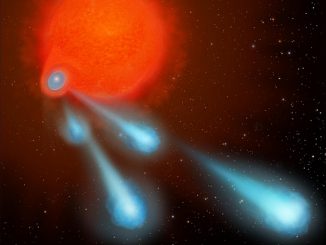Seyfert galaxies resemble quasars, with extremely luminous cores thought to harbour supermassive black holes. But unlike quasars, which shine with a brilliance that masks details of the host galaxy, Seyfert galaxies are clearly visible, closer and less luminous than their more energetic cousins. The prototypical example is Messier 77. NGC 1566, pictured here, is another stunning example, the second brightest Seyfert galaxy yet discovered. Located some 40 million light years from Earth in the constellation Dorado, NGC 1566 is the brightest member of the Dorado Group of galaxies and is classified as an intermediate spiral galaxy, one that does not have a well-defined “bar” in its central region. This image was captured in 2014 by the Hubble Space Telescope’s Wide Field Camera 3.




